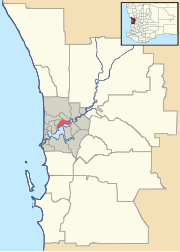Subiaco, Western Australia
|
Subiaco Perth, Western Australia |
|||||||||||||
|---|---|---|---|---|---|---|---|---|---|---|---|---|---|

City of Subiaco council chambers
|
|||||||||||||
| Coordinates | 31°56′56″S 115°49′37″E / 31.949°S 115.827°ECoordinates: 31°56′56″S 115°49′37″E / 31.949°S 115.827°E | ||||||||||||
| Population | 8,015 (2011 census) | ||||||||||||
| • Density | 2,500/km2 (6,490/sq mi) | ||||||||||||
| Established | 1851 | ||||||||||||
| Postcode(s) | 6008 | ||||||||||||
| Area | 3.2 km2 (1.2 sq mi) | ||||||||||||
| Location | 4 km (2 mi) W of Perth CBD | ||||||||||||
| LGA(s) | City of Subiaco | ||||||||||||
| State electorate(s) | Nedlands | ||||||||||||
| Federal Division(s) | Curtin | ||||||||||||
|
|||||||||||||
Subiaco (known colloquially as Subi) is an inner western suburb of Perth, Western Australia, north-west of Kings Park. Its local government area is the City of Subiaco.
Prior to European settlement the area was home to the Noongar Indigenous people.
The area was settled in 1851 by Italian Benedictine monks. The monks named the area after Subiaco in Italy, the location where Benedict of Nursia, the founder of the Order of Saint Benedict, had begun his work.
Landmarks of the suburb include Subiaco Oval aka Domain Stadium, Mueller Park, the Regal Theatre, the Subiaco Hotel, the Victorian terraces on Catherine Street and the Subiaco Arts Centre.
The main street of Subiaco is Rokeby Road, which was named after General Henry Montagu, 6th Baron Rokeby, who was commander of the 1st Infantry Division during the Crimean War. Another important commercial road is Hay Street.
Residential areas include Subi Centro, a modern housing development with the sunken Subiaco railway station on reclaimed industrial land near Wembley, and older heritage properties towards Shenton Park.
...
Wikipedia

